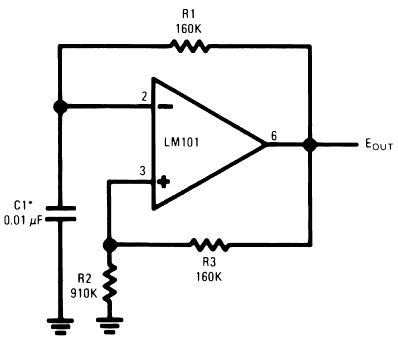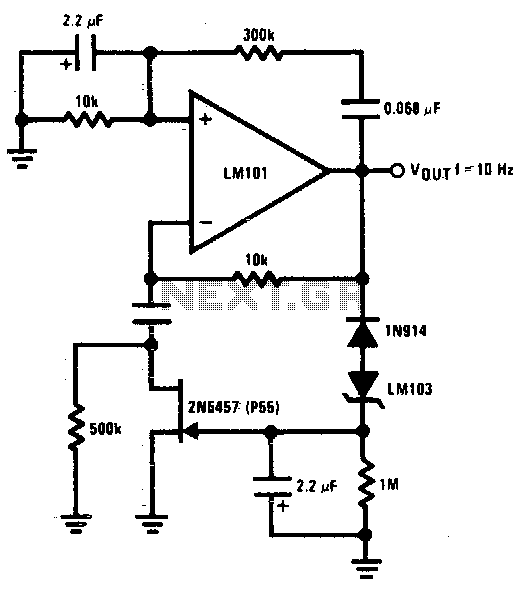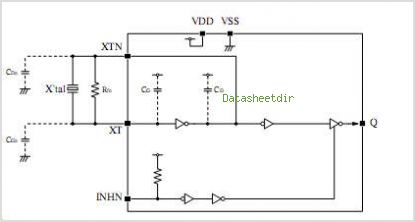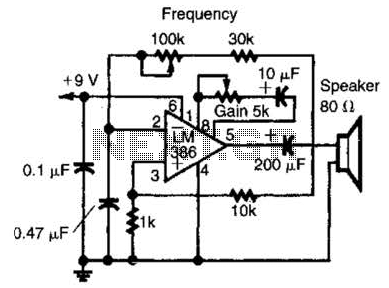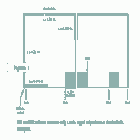
COLPITTS 1 To 20 MHz Crystal Oscillator
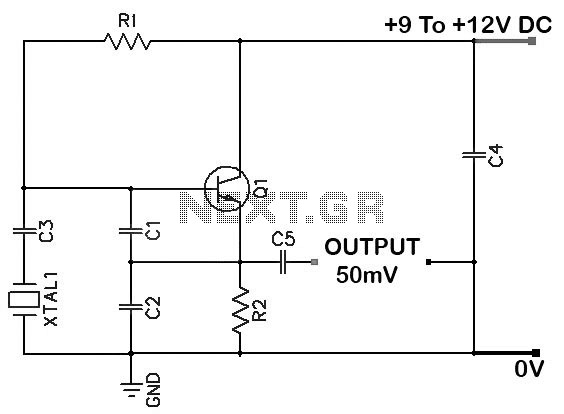
Colpitts 1 MHz to 20 MHz Crystal Oscillator Circuit. This is a simple Colpitts crystal oscillator for frequencies ranging from 1 to 20 MHz. The parts list includes: R1 - 220 kΩ, R2 - 1 kΩ, C1 - 82 pF, C2 - 0.001 µF, C3 - 100 pF, C4 - 0.01 µF, C5 - 0.001 µF, Q1 - 2N3904, and XTAL - crystal (1 to 20 MHz). This circuit can be easily constructed.
The Colpitts oscillator is a type of electronic oscillator that utilizes a combination of capacitors and an inductor to generate oscillations. In this specific design, the oscillator operates within the frequency range of 1 MHz to 20 MHz, making it suitable for various applications, including signal generation and frequency modulation.
The circuit consists of a transistor (Q1 - 2N3904) configured as a common-emitter amplifier, which provides the necessary gain for oscillation. The feedback network is formed by the capacitors (C1, C2, C3, C4, and C5) and the inductor, which together determine the oscillation frequency. The crystal (XTAL) is used to stabilize the frequency of oscillation, ensuring that the output frequency remains consistent and accurate.
The capacitors C1 and C2 form a voltage divider that sets the biasing conditions for the transistor, while C3 and C4 are part of the feedback loop that allows for the regeneration of the oscillation. The choice of values for these components is critical, as they directly influence the frequency of oscillation. The use of a crystal in the circuit helps to achieve a high degree of frequency stability, which is essential in many electronic applications.
Overall, the Colpitts oscillator circuit is a straightforward yet effective design that can be implemented with commonly available components. Its simplicity and reliability make it a popular choice for generating RF signals in various electronic projects. Proper attention to the layout and component placement can further enhance the performance of the oscillator, minimizing noise and ensuring stable operation across the desired frequency range.Colpitts 1MHz To 20 MHz Crystal Oscillator Circuit This is a simple Colpitts crystal oscillator for 1 to 20 MHz, PARTS LISTR1220k?R21k?C182pFC20.001µFC3100pFC40.01µFC50.001µFQ12N3904XTAL1CRYSTAL (1 to 20 MHz) This can be easily made fr.. 🔗 External reference
The Colpitts oscillator is a type of electronic oscillator that utilizes a combination of capacitors and an inductor to generate oscillations. In this specific design, the oscillator operates within the frequency range of 1 MHz to 20 MHz, making it suitable for various applications, including signal generation and frequency modulation.
The circuit consists of a transistor (Q1 - 2N3904) configured as a common-emitter amplifier, which provides the necessary gain for oscillation. The feedback network is formed by the capacitors (C1, C2, C3, C4, and C5) and the inductor, which together determine the oscillation frequency. The crystal (XTAL) is used to stabilize the frequency of oscillation, ensuring that the output frequency remains consistent and accurate.
The capacitors C1 and C2 form a voltage divider that sets the biasing conditions for the transistor, while C3 and C4 are part of the feedback loop that allows for the regeneration of the oscillation. The choice of values for these components is critical, as they directly influence the frequency of oscillation. The use of a crystal in the circuit helps to achieve a high degree of frequency stability, which is essential in many electronic applications.
Overall, the Colpitts oscillator circuit is a straightforward yet effective design that can be implemented with commonly available components. Its simplicity and reliability make it a popular choice for generating RF signals in various electronic projects. Proper attention to the layout and component placement can further enhance the performance of the oscillator, minimizing noise and ensuring stable operation across the desired frequency range.Colpitts 1MHz To 20 MHz Crystal Oscillator Circuit This is a simple Colpitts crystal oscillator for 1 to 20 MHz, PARTS LISTR1220k?R21k?C182pFC20.001µFC3100pFC40.01µFC50.001µFQ12N3904XTAL1CRYSTAL (1 to 20 MHz) This can be easily made fr.. 🔗 External reference
